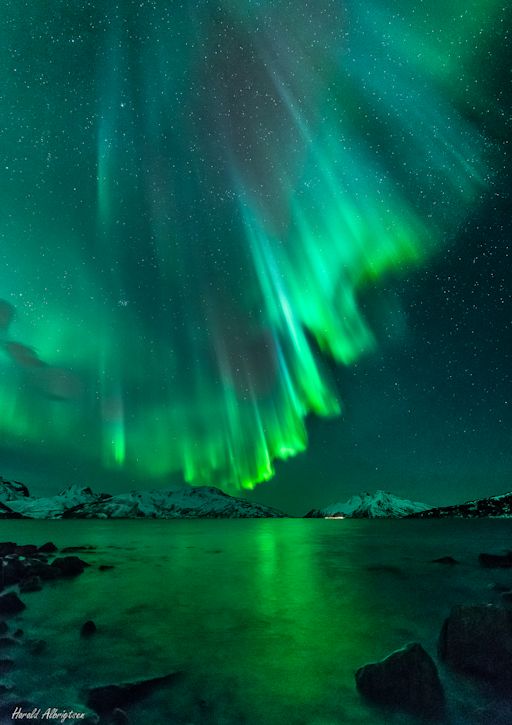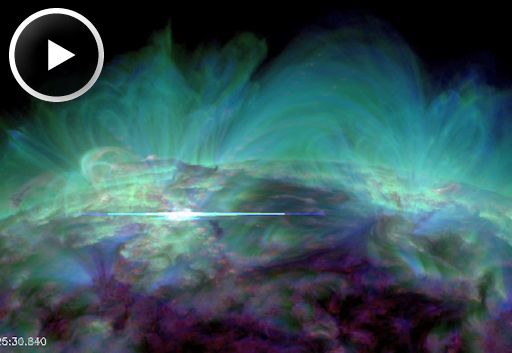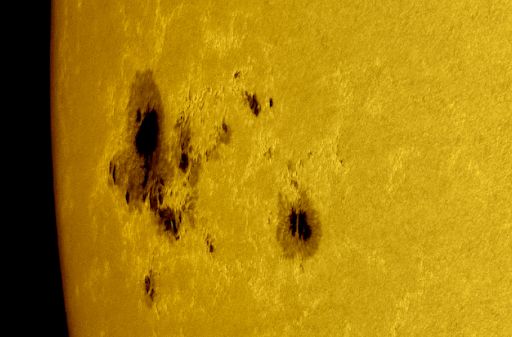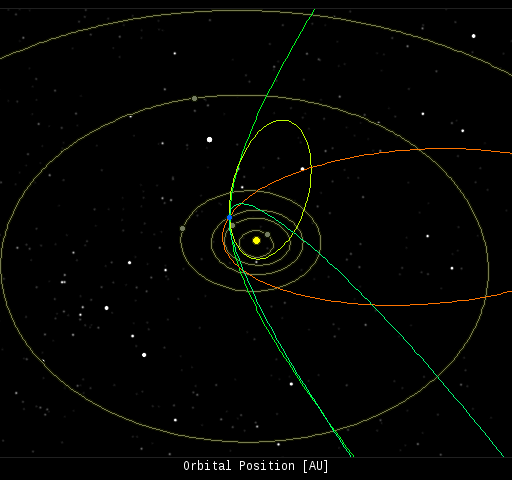When is the best time to see auroras? Where is the best place to go? And how do you photograph them? These questions and more are answered in a new book, Northern Lights - a Guide, by Pal Brekke & Fredrik Broms. | | | LUNAR TRANSIT OF THE SUN: On Thursday, Jan. 30th, the Moon will eclipse the sun for almost 2.5 hours. You have to be in space to see it. NASA's Solar Dynamics Observatory s set to record the "lunar transit," which begins at 1331 UTC or 8:31 EST. A simulation shows that approximately 90% of the sun will covered. SDO is solar powered, so mission controllers have charged-up the spacecraft's batteries to endure the blackout. Stay tuned for images during the eclipse! SOLAR WIND SPARKS SPECTACULAR AURORAS: Earth is entering a stream of solar wind blowing almost 500 km/s or 1.1 million mph. First contact on Jan. 28th sparked tall curtains of light around the Arctic Circle. Harald Albrigtsen sends this picture of the display from Skulsfjord, Tromsø, Norway: 
"At first there was little auroral activity, but being patient paid off," says Albrigtsen. He photographed the explosion of light using a Nikon D600 digital camera set at ISO 3200 iso for 3 seconds. Arctic photographers, take note of those settings because more auroras are on the way. NOAA forecasters estimate a 25% to 40% chance of polar geomagnetic storms on Jan. 29-30 as Earth moves deeper into the solar wind stream. Aurora alerts: text, voice Realtime Aurora Photo Gallery ACTIVE SUNSPOT TURNS TOWARD EARTH: Big sunspot AR1967 near the sun's southeastern limb is crackling with solar flares. As Jan. 29th unfolds it is producing an average of one impulsive M-class explosion every two hours. Sam Freeland of the Lockheed Martin Solar and Astrophysics Lab produced this "interest-compressed" 12.5 hour movie of the active region: 
So far, none of the explosions has been Earth-directed, but future flares will be as the sunspot continues its slow turn toward our planet. NOAA forecasters have doubled the odds of an X-class flare in the next 24 hours to 10%. Meanwhile, M-class flares seem almost certain as the crackling continues. Solar flare alerts: text, voice The primary dark core of AR1967 is twice as wide as Earth. This makes it an easy target for small telescopes equipped with solar filters. This morning at the Langkawi National Observatory in Malaysia, astronomer Karzaman Ahmad photographed the sunspot using an 11-inch Celestron: 
"I wanted to take a closer look at the monster numbered AR1967," says Ahmad. "It is impressive." For more impressive shots of the monster, browse the gallery: Realtime Space Weather Photo Gallery
Realtime Supernova Photo Gallery
Realtime Aurora Photo Gallery
Every night, a network of NASA all-sky cameras scans the skies above the United States for meteoritic fireballs. Automated software maintained by NASA's Meteoroid Environment Office calculates their orbits, velocity, penetration depth in Earth's atmosphere and many other characteristics. Daily results are presented here on Spaceweather.com. On Jan. 29, 2014, the network reported 5 fireballs.
(5 sporadics) 
In this diagram of the inner solar system, all of the fireball orbits intersect at a single point--Earth. The orbits are color-coded by velocity, from slow (red) to fast (blue). [Larger image] [movies] On Jan. 28, 2014, the network reported 7 fireballs.
(7 sporadics) 
In this diagram of the inner solar system, all of the fireball orbits intersect at a single point--Earth. The orbits are color-coded by velocity, from slow (red) to fast (blue). [Larger image] [movies]
Potentially Hazardous Asteroids ( PHAs) are space rocks larger than approximately 100m that can come closer to Earth than 0.05 AU. None of the known PHAs is on a collision course with our planet, although astronomers are finding new ones all the time. On January 29, 2014 there were potentially hazardous asteroids. Notes: LD means "Lunar Distance." 1 LD = 384,401 km, the distance between Earth and the Moon. 1 LD also equals 0.00256 AU. MAG is the visual magnitude of the asteroid on the date of closest approach. | | The official U.S. government space weather bureau | | | The first place to look for information about sundogs, pillars, rainbows and related phenomena. | | | Researchers call it a "Hubble for the sun." SDO is the most advanced solar observatory ever. | | | 3D views of the sun from NASA's Solar and Terrestrial Relations Observatory | | | Realtime and archival images of the Sun from SOHO. | | | from the NOAA Space Environment Center | | | the underlying science of space weather | | 
